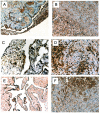Genome-wide profile of pleural mesothelioma versus parietal and visceral pleura: the emerging gene portrait of the mesothelioma phenotype
- PMID: 19662092
- PMCID: PMC2717215
- DOI: 10.1371/journal.pone.0006554
Genome-wide profile of pleural mesothelioma versus parietal and visceral pleura: the emerging gene portrait of the mesothelioma phenotype
Abstract
Background: Malignant pleural mesothelioma is considered an almost incurable tumour with increasing incidence worldwide. It usually develops in the parietal pleura, from mesothelial lining or submesothelial cells, subsequently invading the visceral pleura. Chromosomal and genomic aberrations of mesothelioma are diverse and heterogenous. Genome-wide profiling of mesothelioma versus parietal and visceral normal pleural tissue could thus reveal novel genes and pathways explaining its aggressive phenotype.
Methodology and principal findings: Well-characterised tissue from five mesothelioma patients and normal parietal and visceral pleural samples from six non-cancer patients were profiled by Affymetrix oligoarray of 38 500 genes. The lists of differentially expressed genes tested for overrepresentation in KEGG PATHWAYS (Kyoto Encyclopedia of Genes and Genomes) and GO (gene ontology) terms revealed large differences of expression between visceral and parietal pleura, and both tissues differed from mesothelioma. Cell growth and intrinsic resistance in tumour versus parietal pleura was reflected in highly overexpressed cell cycle, mitosis, replication, DNA repair and anti-apoptosis genes. Several genes of the "salvage pathway" that recycle nucleobases were overexpressed, among them TYMS, encoding thymidylate synthase, the main target of the antifolate drug pemetrexed that is active in mesothelioma. Circadian rhythm genes were expressed in favour of tumour growth. The local invasive, non-metastatic phenotype of mesothelioma, could partly be due to overexpression of the known metastasis suppressors NME1 and NME2. Down-regulation of several tumour suppressor genes could contribute to mesothelioma progression. Genes involved in cell communication were down-regulated, indicating that mesothelioma may shield itself from the immune system. Similarly, in non-cancer parietal versus visceral pleura signal transduction, soluble transporter and adhesion genes were down-regulated. This could represent a genetical platform of the parietal pleura propensity to develop mesothelioma.
Conclusions: Genome-wide microarray approach using complex human tissue samples revealed novel expression patterns, reflecting some important features of mesothelioma biology that should be further explored.
Conflict of interest statement
Figures








Similar articles
-
The circadian clock gene BMAL1 is a novel therapeutic target for malignant pleural mesothelioma.Int J Cancer. 2012 Dec 15;131(12):2820-31. doi: 10.1002/ijc.27598. Epub 2012 May 14. Int J Cancer. 2012. PMID: 22510946 Free PMC article.
-
Malignant pleural mesothelioma: genome-wide expression patterns reflecting general resistance mechanisms and a proposal of novel targets.Lung Cancer. 2010 Jan;67(1):57-68. doi: 10.1016/j.lungcan.2009.03.016. Lung Cancer. 2010. PMID: 19380173
-
Single-cell transcriptomic analysis of human pleura reveals stromal heterogeneity and informs in vitro models of mesothelioma.Eur Respir J. 2024 Jan 25;63(1):2300143. doi: 10.1183/13993003.00143-2023. Print 2024 Jan. Eur Respir J. 2024. PMID: 38212075 Free PMC article.
-
In arrayed ranks: array technology in the study of mesothelioma.J Thorac Oncol. 2009 Mar;4(3):411-25. doi: 10.1097/JTO.0b013e3181951ce8. J Thorac Oncol. 2009. PMID: 19247089 Review.
-
Defective core-apoptosis signalling in diffuse malignant pleural mesothelioma: opportunities for effective drug development.Lancet Oncol. 2004 Jun;5(6):354-62. doi: 10.1016/S1470-2045(04)01492-5. Lancet Oncol. 2004. PMID: 15172356 Review.
Cited by
-
Genetic variants associated with increased risk of malignant pleural mesothelioma: a genome-wide association study.PLoS One. 2013 Apr 23;8(4):e61253. doi: 10.1371/journal.pone.0061253. Print 2013. PLoS One. 2013. PMID: 23626673 Free PMC article.
-
The circadian clock gene BMAL1 is a novel therapeutic target for malignant pleural mesothelioma.Int J Cancer. 2012 Dec 15;131(12):2820-31. doi: 10.1002/ijc.27598. Epub 2012 May 14. Int J Cancer. 2012. PMID: 22510946 Free PMC article.
-
A novel PDX modeling strategy and its application in metabolomics study for malignant pleural mesothelioma.BMC Cancer. 2021 Nov 17;21(1):1235. doi: 10.1186/s12885-021-08980-5. BMC Cancer. 2021. PMID: 34789172 Free PMC article.
-
miR-193a-3p is a potential tumor suppressor in malignant pleural mesothelioma.Oncotarget. 2015 Sep 15;6(27):23480-95. doi: 10.18632/oncotarget.4346. Oncotarget. 2015. PMID: 26125439 Free PMC article.
-
CTP synthase 1, a smooth muscle-sensitive therapeutic target for effective vascular repair.Arterioscler Thromb Vasc Biol. 2013 Oct;33(10):2336-44. doi: 10.1161/ATVBAHA.113.301561. Epub 2013 Sep 5. Arterioscler Thromb Vasc Biol. 2013. PMID: 24008161 Free PMC article.
References
-
- Robinson BW, Musk AW, Lake RA. Malignant mesothelioma. Lancet. 2005;366:397–408. - PubMed
-
- Baas P. Chemotherapy for malignant mesothelioma. Lung Cancer. 2005;49(Suppl 1):S61–64. - PubMed
-
- Boutin C, Rey F. Thoracoscopy in pleural malignant mesothelioma: a prospective study of 188 consecutive patients. Part 1: Diagnosis. Cancer. 1993;72:389–393. - PubMed
-
- Lindholm PM, Salmenkivi K, Vauhkonen H, Nicholson AG, Anttila S, et al. Gene copy number analysis in malignant pleural mesothelioma using oligonucleotide array CGH. Cytogenet Genome Res. 2007;119:46–52. - PubMed
Publication types
MeSH terms
LinkOut - more resources
Full Text Sources
Other Literature Sources
Medical
Research Materials
Miscellaneous

